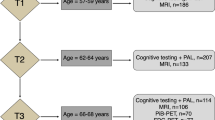Summary.
Normal aging of the brain is predominantly characterized by metabolic changes in the prefrontal cortex. While in middle age there is a trend to hyperfrontality, PET demonstrates in old age a decline of regional cerebral glucose metabolism in frontal areas. In progeric diseases, clinically apparent as premature aging, the metabolic pattern is similar like in normal aging but qualitatively more severe. In patients with the diagnosis of probable Alzheimer's disease (AD) hypometabolism in early dementia is typically present in heteromodal association areas. Hypometabolism then spreads to other cortical and subcortical regions suggesting a characteristic pattern of degeneration that reflects selective vulnerability within limbic-cortical networks. Synaptic plasticity, clinically apparent as cognitive reserve capacity, can be assessed by PET under specific cognitive activation. In AD it is reduced in comparison to age-matched normals and may be influenced by drugs giving trophic support to neurochemical systems.
Similar content being viewed by others
Author information
Authors and Affiliations
Additional information
Received December 17, 1997; accepted April 23, 1998
Rights and permissions
About this article
Cite this article
Mielke, R., Kessler, J., Szelies, B. et al. Normal and pathological aging – findings of positron-emission-tomography. J Neural Transm 105, 821–837 (1998). https://doi.org/10.1007/s007020050097
Issue Date:
DOI: https://doi.org/10.1007/s007020050097




